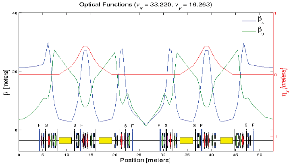First demonstration of the fast-to-slow corrector current shift in the NSLS-II storage ring
Abstract
In order to realize the full benefits of the high brightness and ultra-small beam sizes of NSLS-II, it is essential that the photon beams are exceedingly stable. In the circumstances of implementing local bumps, changing ID gaps, and long term drifting, the fast orbit feedback (FOFB) requires shifting the fast corrector strengths to the slow correctors to prevent the fast corrector saturation and to make the beam orbit stable in the sub-micron level. As the result, a reliable and precise technique of fast-to-slow corrector strength shift has been developed and tested at NSLS-II. This technique is based on the fast corrector response to the slow corrector change when the FOFB is on. In this article, the shift technique is described and the result of proof-of-principle experiment carried out at NSLS-II is presented. The maximum fast corrector current was reduced from greater than 0.45 A to less than 0.04 A with the orbit perturbation within ±1 μm.
- Authors:
-
- Brookhaven National Laboratory (BNL), Upton, NY (United States). National Synchrotron Light Source II (NSLS-II)
- Publication Date:
- Research Org.:
- Brookhaven National Laboratory (BNL), Upton, NY (United States). National Synchrotron Light Source II (NSLS-II)
- Sponsoring Org.:
- USDOE Office of Science (SC), Basic Energy Sciences (BES)
- OSTI Identifier:
- 1426454
- Alternate Identifier(s):
- OSTI ID: 1548825
- Report Number(s):
- BNL-203343-2018-JAAM
Journal ID: ISSN 0168-9002; TRN: US1802285
- Grant/Contract Number:
- SC0012704; AC02-98CH10886
- Resource Type:
- Accepted Manuscript
- Journal Name:
- Nuclear Instruments and Methods in Physics Research. Section A, Accelerators, Spectrometers, Detectors and Associated Equipment
- Additional Journal Information:
- Journal Volume: 886; Journal Issue: C; Journal ID: ISSN 0168-9002
- Publisher:
- Elsevier
- Country of Publication:
- United States
- Language:
- English
- Subject:
- 43 PARTICLE ACCELERATORS; 70 PLASMA PHYSICS AND FUSION TECHNOLOGY; Synchrotron light source; orbit stability; feedback system
Citation Formats
Yang, Xi, Tian, Yuke, Yu, Li Hua, and Smaluk, Victor. First demonstration of the fast-to-slow corrector current shift in the NSLS-II storage ring. United States: N. p., 2018.
Web. doi:10.1016/j.nima.2018.01.006.
Yang, Xi, Tian, Yuke, Yu, Li Hua, & Smaluk, Victor. First demonstration of the fast-to-slow corrector current shift in the NSLS-II storage ring. United States. https://doi.org/10.1016/j.nima.2018.01.006
Yang, Xi, Tian, Yuke, Yu, Li Hua, and Smaluk, Victor. Sun .
"First demonstration of the fast-to-slow corrector current shift in the NSLS-II storage ring". United States. https://doi.org/10.1016/j.nima.2018.01.006. https://www.osti.gov/servlets/purl/1426454.
@article{osti_1426454,
title = {First demonstration of the fast-to-slow corrector current shift in the NSLS-II storage ring},
author = {Yang, Xi and Tian, Yuke and Yu, Li Hua and Smaluk, Victor},
abstractNote = {In order to realize the full benefits of the high brightness and ultra-small beam sizes of NSLS-II, it is essential that the photon beams are exceedingly stable. In the circumstances of implementing local bumps, changing ID gaps, and long term drifting, the fast orbit feedback (FOFB) requires shifting the fast corrector strengths to the slow correctors to prevent the fast corrector saturation and to make the beam orbit stable in the sub-micron level. As the result, a reliable and precise technique of fast-to-slow corrector strength shift has been developed and tested at NSLS-II. This technique is based on the fast corrector response to the slow corrector change when the FOFB is on. In this article, the shift technique is described and the result of proof-of-principle experiment carried out at NSLS-II is presented. The maximum fast corrector current was reduced from greater than 0.45 A to less than 0.04 A with the orbit perturbation within ±1 μm.},
doi = {10.1016/j.nima.2018.01.006},
journal = {Nuclear Instruments and Methods in Physics Research. Section A, Accelerators, Spectrometers, Detectors and Associated Equipment},
number = C,
volume = 886,
place = {United States},
year = {Sun Apr 01 00:00:00 EDT 2018},
month = {Sun Apr 01 00:00:00 EDT 2018}
}
Web of Science
Figures / Tables:
 Fig. 1: Beta functions and dispersion (top) and machine elements (bottom) in a super-period. In the bottom, positions of fast correctors and slow correctors are indicated by vertical blue lines with label ‘F’ and vertical black lines with label ‘S’ respectively.
Fig. 1: Beta functions and dispersion (top) and machine elements (bottom) in a super-period. In the bottom, positions of fast correctors and slow correctors are indicated by vertical blue lines with label ‘F’ and vertical black lines with label ‘S’ respectively.
Figures / Tables found in this record:

 Search WorldCat to find libraries that may hold this journal
Search WorldCat to find libraries that may hold this journal